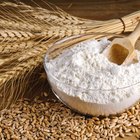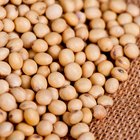
Some recipes call specifically for either unbleached or bleached all-purpose flour. The difference between the two types is negligible; bleaching is done with chemicals that give the flour a whiter hue, while unbleached is slightly creamier in color. Bottom line: All-purpose flour was created so that home bakers wouldn't have to buy a multitude of different flours for home baking needs, and interchanging bleached for unbleached in any recipe won't produce a significant difference.
The Gluten Factor
The chemical bleaching process destroys some of the proteins in flour, arguably changing the outcome of certain baked goods. Protein, or gluten, in flour contributes to the stretchiness factor in dough, and when making yeast products, gluten is important to lock in the gas bubbles produced by yeast. When baking with chemical leaveners such as baking powder, however, gluten's stretchy heaviness actually gets in the way. In these cases, less protein in flour is actually desirable to produce a lighter baked good. With this in mind, unbleached flour may produce a better yeast bread dough than bleached, and bleached might be more desirable in cookies, but the difference will be marginal.
Related Articles

Differences Between Bleached Flour & ...

How to Preserve Dough That Has Risen

Can You Substitute Yogurt for ...
What Is the Difference Between Cake ...

How Long Does Banana Bread Stay Fresh?

How to Freeze Brioche

How to Make Bread Chewy

How to Substitute Cornstarch for ...

How to Add Gluten to All-Purpose Flour

Can You Substitute Butter for ...

What Are the Causes of Pie & Pastry ...

How to Bake With Besan Flour

Can You Use Malt Vinegar in Place of ...

How Many Calories in Gluten-Free Bread?

Does Yeast Cause Holes in Bread?
Does Cake Flour Contain Baking Soda & ...

What Are Ingredients in Wheat Bread?

How to Make Pumpkin Bread Moist

What Kind of Flour to Use for Cupcakes?

Is Soy Flour Healthy?
References
Writer Bio
Kimberly Blough is a food junkie residing in San Diego who began writing professionally in 2013. She obtained her Bachelor of Arts in geography from San Diego State University in 2003 and has taught culinary classes in various capacities since 2005. She teaches cheesemaking workshops and lives on a small hobby farm where she turns the food they grow into delectable dishes.
Photo Credits
Jupiterimages/Photos.com/Getty Images